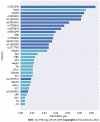Comparison and development of machine learning for thalidomide-induced peripheral neuropathy prediction of refractory Crohn's disease in Chinese population
- PMID: 37426324
- PMCID: PMC10324537
- DOI: 10.3748/wjg.v29.i24.3855
Comparison and development of machine learning for thalidomide-induced peripheral neuropathy prediction of refractory Crohn's disease in Chinese population
Abstract
Background: Thalidomide is an effective treatment for refractory Crohn's disease (CD). However, thalidomide-induced peripheral neuropathy (TiPN), which has a large individual variation, is a major cause of treatment failure. TiPN is rarely predictable and recognized, especially in CD. It is necessary to develop a risk model to predict TiPN occurrence.
Aim: To develop and compare a predictive model of TiPN using machine learning based on comprehensive clinical and genetic variables.
Methods: A retrospective cohort of 164 CD patients from January 2016 to June 2022 was used to establish the model. The National Cancer Institute Common Toxicity Criteria Sensory Scale (version 4.0) was used to assess TiPN. With 18 clinical features and 150 genetic variables, five predictive models were established and evaluated by the confusion matrix receiver operating characteristic curve (AUROC), area under the precision-recall curve (AUPRC), specificity, sensitivity (recall rate), precision, accuracy, and F1 score.
Results: The top-ranking five risk variables associated with TiPN were interleukin-12 rs1353248 [P = 0.0004, odds ratio (OR): 8.983, 95% confidence interval (CI): 2.497-30.90], dose (mg/d, P = 0.002), brain-derived neurotrophic factor (BDNF) rs2030324 (P = 0.001, OR: 3.164, 95%CI: 1.561-6.434), BDNF rs6265 (P = 0.001, OR: 3.150, 95%CI: 1.546-6.073) and BDNF rs11030104 (P = 0.001, OR: 3.091, 95%CI: 1.525-5.960). In the training set, gradient boosting decision tree (GBDT), extremely random trees (ET), random forest, logistic regression and extreme gradient boosting (XGBoost) obtained AUROC values > 0.90 and AUPRC > 0.87. Among these models, XGBoost and GBDT obtained the first two highest AUROC (0.90 and 1), AUPRC (0.98 and 1), accuracy (0.96 and 0.98), precision (0.90 and 0.95), F1 score (0.95 and 0.98), specificity (0.94 and 0.97), and sensitivity (1). In the validation set, XGBoost algorithm exhibited the best predictive performance with the highest specificity (0.857), accuracy (0.818), AUPRC (0.86) and AUROC (0.89). ET and GBDT obtained the highest sensitivity (1) and F1 score (0.8). Overall, compared with other state-of-the-art classifiers such as ET, GBDT and RF, XGBoost algorithm not only showed a more stable performance, but also yielded higher ROC-AUC and PRC-AUC scores, demonstrating its high accuracy in prediction of TiPN occurrence.
Conclusion: The powerful XGBoost algorithm accurately predicts TiPN using 18 clinical features and 14 genetic variables. With the ability to identify high-risk patients using single nucleotide polymorphisms, it offers a feasible option for improving thalidomide efficacy in CD patients.
Keywords: Gene polymorphisms; Machine learning; Neurotoxicity prediction models; Refractory Crohn’s disease; Thalidomide-induced peripheral neuropathy.
©The Author(s) 2023. Published by Baishideng Publishing Group Inc. All rights reserved.
Conflict of interest statement
Conflict-of-interest statement: The authors declare that the research was conducted in the absence of any commercial or financial relationships that could be construed as a potential conflict of interest.
Figures






Similar articles
-
Machine learning-based predictive models for perioperative major adverse cardiovascular events in patients with stable coronary artery disease undergoing noncardiac surgery.Comput Methods Programs Biomed. 2025 Mar;260:108561. doi: 10.1016/j.cmpb.2024.108561. Epub 2024 Dec 13. Comput Methods Programs Biomed. 2025. PMID: 39708562
-
Risk Factors and Outcomes of Thalidomide-induced Peripheral Neuropathy in a Pediatric Inflammatory Bowel Disease Cohort.Inflamm Bowel Dis. 2017 Oct;23(10):1810-1816. doi: 10.1097/MIB.0000000000001195. Inflamm Bowel Dis. 2017. PMID: 28817461
-
Establishment of noninvasive diabetes risk prediction model based on tongue features and machine learning techniques.Int J Med Inform. 2021 May;149:104429. doi: 10.1016/j.ijmedinf.2021.104429. Epub 2021 Feb 22. Int J Med Inform. 2021. PMID: 33647600
-
Predicting adverse drug event using machine learning based on electronic health records: a systematic review and meta-analysis.Front Pharmacol. 2024 Nov 13;15:1497397. doi: 10.3389/fphar.2024.1497397. eCollection 2024. Front Pharmacol. 2024. PMID: 39605909 Free PMC article.
-
Incidence, description, predictors, and consequences of persistent taxane-induced peripheral neuropathy.Curr Opin Support Palliat Care. 2024 Mar 1;18(1):30-38. doi: 10.1097/SPC.0000000000000684. Epub 2024 Dec 6. Curr Opin Support Palliat Care. 2024. PMID: 38126251 Review.
Cited by
-
A review of thalidomide and digestive system related diseases.Front Oncol. 2025 May 29;15:1543757. doi: 10.3389/fonc.2025.1543757. eCollection 2025. Front Oncol. 2025. PMID: 40510146 Free PMC article. Review.
-
Efficient diagnosis for endoscopic remission in Crohn's diseases by the combination of three non-invasive markers.BMC Gastroenterol. 2025 May 13;25(1):364. doi: 10.1186/s12876-025-03880-5. BMC Gastroenterol. 2025. PMID: 40355822 Free PMC article.
References
-
- Lazzerini M, Martelossi S, Magazzù G, Pellegrino S, Lucanto MC, Barabino A, Calvi A, Arrigo S, Lionetti P, Lorusso M, Mangiantini F, Fontana M, Zuin G, Palla G, Maggiore G, Bramuzzo M, Pellegrin MC, Maschio M, Villanacci V, Manenti S, Decorti G, De Iudicibus S, Paparazzo R, Montico M, Ventura A. Effect of thalidomide on clinical remission in children and adolescents with refractory Crohn disease: a randomized clinical trial. JAMA. 2013;310:2164–2173. - PubMed
-
- Mileshkin L, Stark R, Day B, Seymour JF, Zeldis JB, Prince HM. Development of neuropathy in patients with myeloma treated with thalidomide: patterns of occurrence and the role of electrophysiologic monitoring. J Clin Oncol. 2006;24:4507–4514. - PubMed
-
- Franks ME, Macpherson GR, Figg WD. Thalidomide. Lancet. 2004;363:1802–1811. - PubMed
-
- Selvy M, Kerckhove N, Pereira B, Barreau F, Nguyen D, Busserolles J, Giraudet F, Cabrespine A, Chaleteix C, Soubrier M, Bay JO, Lemal R, Balayssac D. Prevalence of Chemotherapy-Induced Peripheral Neuropathy in Multiple Myeloma Patients and its Impact on Quality of Life: A Single Center Cross-Sectional Study. Front Pharmacol. 2021;12:637593. - PMC - PubMed
MeSH terms
Substances
LinkOut - more resources
Full Text Sources
Medical

